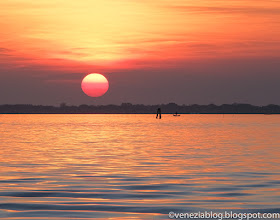The Regata Storica held at the end of each summer on the Grand Canal is the most famous rowing event in Venice, but it's just one of a series of regate--known in total as il circuito--which begins in the spring and runs almost to the end of November.
Last Sunday in the south lagoon behind the Giudecca, as part of the 20th Festa Grande de Sant'Andrea, was the last event of the circuito, and after what seemed like two weeks of uninterrupted gloom and drizzle (not unusual for November) it brought an abundance of welcome color to the lagoon.
It was also the first regata in which our 10-year-old son competed, in the Schìe (basically "waterbug") division. Having had but one day of practice with a new rowing partner, and rowing in the prua (prow) position instead of the poppa to which he was accustomed, he and his partner posed little threat to the eventual winners, but that was never really the point. It was his chance to get his feet wet (so to speak) in regate, and he enjoyed it thoroughly.
There were other races as well--such as the four-oar women's competition at top--but the highlight of the day was a final race of 50 six-rower caorline.
The most accomplished crews of Regatanti that started in the front of the pack competed fiercely along the whole 3.55 meter course and first place came down to a photo finish (as you can see in the third photo below). But the overall aim of the event was to close the season with a sense of community, in which rowers with differing degrees of expertise and competitive drive could share.
I learned it's really impossible to capture more than a small fraction of 50 caorline in one shot, but I hope these images provide some sense of the event.
 |
| The shirts of this crew basically declare (in Venetian): "We don't need gas, our turbo fuel tank is in our arms" |
 |
| Although I couldn't tell who won from my vantage point, it turned out to be the crew in the black and white stripes |
 |
| As the winners caught their breath a good part of the rest of the 50 caorline had yet to finish |
 |
| A good number of spectators watched from their own boats (like these three, here chatting with someone on the flooded fondamenta before the races began) |



















